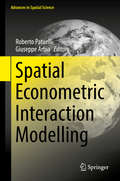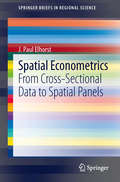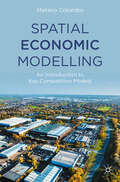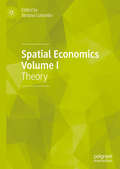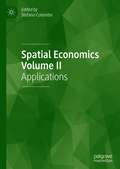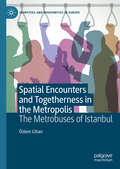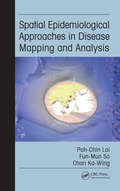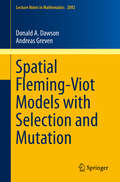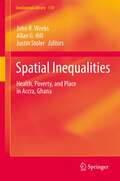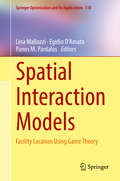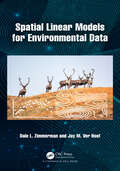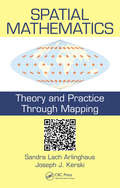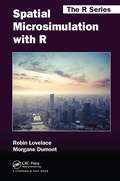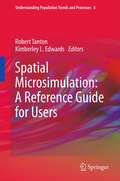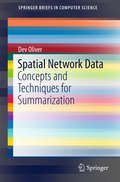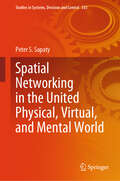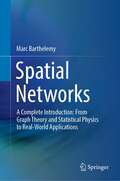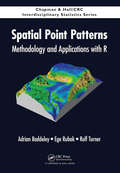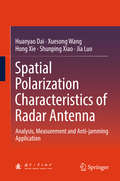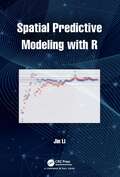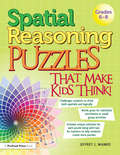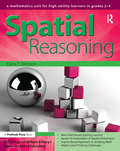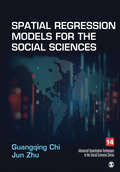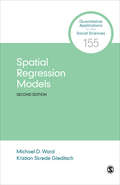- Table View
- List View
Spatial Econometric Interaction Modelling
by Roberto Patuelli Giuseppe ArbiaThis contributed volume applies spatial and space-time econometric methods to spatial interaction modeling. The first part of the book addresses general cutting-edge methodological questions in spatial econometric interaction modeling, which concern aspects such as coefficient interpretation, constrained estimation, and scale effects. The second part deals with technical solutions to particular estimation issues, such as intraregional flows, Bayesian PPML and VAR estimation. The final part presents a number of empirical applications, ranging from interregional tourism competition and domestic trade to space-time migration modeling and residential relocation.
Spatial Econometrics
by J. Paul ElhorstThis book provides an overview of three generations of spatial econometric models: models based on cross-sectional data, static models based on spatial panels and dynamic spatial panel data models. The book not only presents different model specifications and their corresponding estimators, but also critically discusses the purposes for which these models can be used and how their results should be interpreted.
Spatial Economic Modelling: An Introduction to Key Competition Models
by Stefano ColomboThis textbook provides an accessible introduction to spatial competition models in economics. It shows students how to understand and apply spatial models to analysis of market design, structure, competition and pricing. The book aims to provide a step-by-step guide to learning and implementing spatial modelling. It provides a concise history of the spatial approach and a self-contained primer chapter on the key game theory tools required to undertake spatial analysis. It then provides a comprehensive explanation of the key traditions and models, including the Hotelling model and related Salop circle model, and demonstrates their various applications to consumer, firm and market interactions. Topics covered in the book include: product differentiation, the physical location of firms, spatial price discrimination, oligopolistic competition, non-uniform distributions of consumers, political competition and the basic Downs model, and the application of spatial models to marketing and management. This book will be a valuable resource for undergraduate students in microeconomics and applied economics, particularly on industrial organization courses.
Spatial Economics Volume I: Theory
by Stefano ColomboSpace is a crucial variable in any economic activity. Spatial Economics is the branch of economics that explicitly aims to incorporate the space dimension in the analysis of economic phenomena. From its beginning in the last century, Spatial Economics has contributed to the understanding of the economy by developing plenty of theoretical models as well as econometric techniques having the “space” as a core dimension of the analysis. This edited volume addresses the complex issue of Spatial Economics from a theoretical point of view. This volume is part of a more complex project including another edited volume (Spatial Economics Volume II: Applications) collecting original papers which address Spatial Economics from an applied perspective.
Spatial Economics Volume II: Applications
by Stefano ColomboSpace is a crucial variable in any economic activity. Spatial Economics is the branch of economics that explicitly aims to incorporate the space dimension in the analysis of economic phenomena. From its beginning in the last century, Spatial Economics has contributed to the understanding of the economy by developing plenty of theoretical models as well as econometric techniques having the “space” as a core dimension of the analysis.This edited volume addresses the complex issue of Spatial Economics from an applied point of view. This volume is part of a more complex project including another edited volume (Spatial Economics Volume I: Theory) collecting original papers which address Spatial Economics from a theoretical perspective.
Spatial Encounters and Togetherness in the Metropolis: The Metrobuses of Istanbul (Identities and Modernities in Europe)
by Özlem CihanThis book analyzes Istanbul's bus rapid transit, the metrobus, as an encountering space to unfold the perception and practice of togetherness. Based on field research with regular metrobus passengers, the book presents a layered analysis between everyday life, everyday mobility, and togetherness to emphasize the metropolitan impact on the socio-spatial experience and subjectification. By articulating Lefebvrian social space in a metropolitan context, the book discusses that Istanbul's spatially and temporally framed everydayness leads inhabitants to the need for bus rapid transit. On the other hand, the need for the metrobus produces transit modes of experience in regulars' socio-spatial relation and subjectification. As a result, encountering and being with the unfamiliar and diverse others undertake the framed typologies of the first two layers and produce a dissolving essence in the idea and practice of togetherness in Istanbul.
Spatial Epidemiological Approaches in Disease Mapping and Analysis
by Poh-Chin Lai Fun-Mun So Ka-Wing ChanContaining method descriptions and step-by-step procedures, the Spatial Epidemiological Approaches in Disease Mapping and Analysis equips readers with skills to prepare health-related data in the proper format, process these data using relevant functions and software, and display the results as mapped or statistical summaries. Describing the wide r
Spatial Fleming-Viot Models with Selection and Mutation
by Donald A. Dawson Andreas GrevenThis book constructs a rigorous framework for analysing selected phenomena in evolutionary theory of populations arising due to the combined effects of migration, selection and mutation in a spatial stochastic population model, namely the evolution towards fitter and fitter types through punctuated equilibria. The discussion is based on a number of new methods, in particular multiple scale analysis, nonlinear Markov processes and their entrance laws, atomic measure-valued evolutions and new forms of duality (for state-dependent mutation and multitype selection) which are used to prove ergodic theorems in this context and are applicable for many other questions and renormalization analysis for a variety of phenomena (stasis, punctuated equilibrium, failure of naive branching approximations, biodiversity) which occur due to the combination of rare mutation, mutation, resampling, migration and selection and make it necessary to mathematically bridge the gap (in the limit) between time and space scales.
Spatial Inequalities
by Allan G. Hill Justin Stoler John R. WeeksThis book provides a fresh analysis of the demography, health and well-being of a major African city. It brings a range of disciplinary approaches to bear on the pressing topics of urban poverty, urban health inequalities and urban growth. The approach is primarily spatial and includes the integration of environmental information from satellites and other geospatial sources with social science and health survey data. The authors Ghanaians and outsiders, have worked to understand the urban dynamics in this burgeoning West African metropolis, with an emphasis on urban disparities in health and living standards. Few cities in the global South have been examined from so many different perspectives. Our analysis employs a wide range of GIScience methods, including analysis of remotely sensed imagery and spatial statistical analysis, applied to a wide range of data, including census, survey and health clinic data, all of which are supplemented by field work, including systematic social observation, focus groups, and key informant interviews. This book aims to explain and highlight the mix of methods, and the important findings that have been emerging from this research, with the goal of providing guidance and inspiration for others doing similar work in cities of other developing nations.
Spatial Interaction Models
by Panos M. Pardalos Lina Mallozzi Egidio D’amatoFacility location theory develops the idea of locating one or more facilities by optimizing suitable criteria such as minimizing transportation cost, or capturing the largest market share. The contributions in this book focus an approach to facility location theory through game theoretical tools highlighting situations where a location decision is faced by several decision makers and leading to a game theoretical framework in non-cooperative and cooperative methods. Models and methods regarding the facility location via game theory are explored and applications are illustrated through economics, engineering, and physics. Mathematicians, engineers, economists and computer scientists working in theory, applications and computational aspects of facility location problems using game theory will find this book useful.
Spatial Linear Models for Environmental Data (Chapman & Hall/CRC Applied Environmental Statistics)
by Dale L. Zimmerman Jay M. Ver HoefMany applied researchers equate spatial statistics with prediction or mapping, but this book naturally extends linear models, which includes regression and ANOVA as pillars of applied statistics, to achieve a more comprehensive treatment of the analysis of spatially autocorrelated data. Spatial Linear Models for Environmental Data, aimed at students and professionals with a master’s level training in statistics, presents a unique, applied, and thorough treatment of spatial linear models within a statistics framework. Two subfields, one called geostatistics and the other called areal or lattice models, are extensively covered. Zimmerman and Ver Hoef present topics clearly, using many examples and simulation studies to illustrate ideas. By mimicking their examples and R code, readers will be able to fit spatial linear models to their data and draw proper scientific conclusions. Topics covered include: Exploratory methods for spatial data including outlier detection, (semi)variograms, Moran’s I, and Geary’s c. Ordinary and generalized least squares regression methods and their application to spatial data. Suitable parametric models for the mean and covariance structure of geostatistical and areal data. Model-fitting, including inference methods for explanatory variables and likelihood-based methods for covariance parameters. Practical use of spatial linear models including prediction (kriging), spatial sampling, and spatial design of experiments for solving real world problems. All concepts are introduced in a natural order and illustrated throughout the book using four datasets. All analyses, tables, and figures are completely reproducible using open-source R code provided at a GitHub site. Exercises are given at the end of each chapter, with full solutions provided on an instructor’s FTP site supplied by the publisher.
Spatial Mathematics: Theory and Practice through Mapping
by Joseph J. Kerski Sandra Lach ArlinghausIn terms of statistics, GIS offers many connections. With GIS, data are gathered, displayed, summarized, examined, and interpreted to discover patterns. Spatial Mathematics: Theory and Practice through Mapping uses GIS as a platform to teach mathematical concepts and skills through visualization of numbers. It examines theory and practice from disp
Spatial Microsimulation with R (Chapman & Hall/CRC The R Series)
by Robin Lovelace Morgane DumontGenerate and Analyze Multi-Level Data Spatial microsimulation involves the generation, analysis, and modeling of individual-level data allocated to geographical zones. Spatial Microsimulation with R is the first practical book to illustrate this approach in a modern statistical programming language. Get Insight into Complex BehaviorsThe book progresses from the principles underlying population synthesis toward more complex issues such as household allocation and using the results of spatial microsimulation for agent-based modeling. This equips you with the skills needed to apply the techniques to real-world situations. The book demonstrates methods for population synthesis by combining individual and geographically aggregated datasets using the recent R packages ipfp and mipfp. This approach represents the "best of both worlds" in terms of spatial resolution and person-level detail, overcoming issues of data confidentiality and reproducibility. Implement the Methods on Your Own DataFull of reproducible examples using code and data, the book is suitable for students and applied researchers in health, economics, transport, geography, and other fields that require individual-level data allocated to small geographic zones. By explaining how to use tools for modeling phenomena that vary over space, the book enhances your knowledge of complex systems and empowers you to provide evidence-based policy guidance.
Spatial Microsimulation: A Reference Guide for Users
by Kimberley Edwards Robert TantonThis book is a practical guide on how to design, create and validate a spatial microsimulation model. These models are becoming more popular as academics and policy makers recognise the value of place in research and policy making. Recent spatial microsimulation models have been used to analyse health and social disadvantage for small areas; and to look at the effect of policy change for small areas. This provides a powerful analysis tool for researchers and policy makers. This book covers preparing the data for spatial microsimulation; a number of methods for both static and dynamic spatial microsimulation models; validation of the models to ensure the outputs are reasonable; and the future of spatial microsimulation. The book will be an essential handbook for any researcher or policy maker looking to design and create a spatial microsimulation model. This book will also be useful to those policy makers who are commissioning a spatial microsimulation model, or looking to commission work using a spatial microsimulation model, as it provides information on the different methods in a non-technical way.
Spatial Network Data
by Dev OliverThis brief explores two of the main challenges of spatial network data analysis: the many connected components in the spatial network and the many candidates that have to be processed. Within this book, these challenges are conceptualized, well-defined problems are explored, and critical techniques are discussed. The process of summarizing spatial network data entails finding a compact description or representation of observations or activities on large spatial or spatiotemporal networks. However, summarizing spatial network data can be computationally challenging for various reasons, depending on the domain. The content has applications for professionals, organizations, and researchers in transportation safety, public safety, public health, disaster response, and related fields.
Spatial Networking in the United Physical, Virtual, and Mental World (Studies in Systems, Decision and Control #533)
by Peter S. SapatyThe current book chooses graphs and networks as primary and global research objectives after reviewing different types and areas of networking and existing works on graph and network operations. The ideas of this book originate from the WAVE approach which allowed us, more than half a century ago, to implement citywide heterogeneous computer networks and solve distributed problems on them in flexible and mobile way. The invented management paradigm evolved into Spatial Grasp Technology resulted in European patent and nine previous books oriented on concrete applications in social and defense systems, security, crises management, collective robotics, space research, and others. Many obtained results were dealing with graph and network structures and problems which were extremely important in the researched areas. It aims at development of higher-level social infrastructures effectively integrating different types of networking under the same universal approach, also application of networking in new areas like organoids and brain research. This book is oriented toward system scientists, application programmers, industry managers, university students, philosophers, psychologists, and United Nations personnel too.
Spatial Networks: A Complete Introduction: From Graph Theory and Statistical Physics to Real-World Applications (Lecture Notes In Morphogenesis Ser.)
by Marc BarthelemyThis book provides a complete introduction into spatial networks. It offers the mathematical tools needed to characterize these structures and how they evolve in time and presents the most important models of spatial networks.The book puts a special emphasis on analyzing complex systems which are organized under the form of networks where nodes and edges are embedded in space. In these networks, space is relevant, and topology alone does not contain all the information. Characterizing and understanding the structure and the evolution of spatial networks is thus crucial for many different fields, ranging from urbanism to epidemiology.This subject is therefore at the crossroad of many fields and is of potential interest to a broad audience comprising physicists, mathematicians, engineers, geographers or urbanists. In this book, the author has expanded his previous book ("Morphogenesis of Spatial Networks") to serve as a textbook and reference on this topic for a wide range of students and professional researchers.
Spatial Point Patterns: Methodology and Applications with R (Chapman & Hall/CRC Interdisciplinary Statistics)
by Adrian Baddeley Ege Rubak Rolf TurnerModern Statistical Methodology and Software for Analyzing Spatial Point PatternsSpatial Point Patterns: Methodology and Applications with R shows scientific researchers and applied statisticians from a wide range of fields how to analyze their spatial point pattern data. Making the techniques accessible to non-mathematicians, the authors draw on th
Spatial Polarization Characteristics of Radar Antenna: Analysis, Measurement and Anti-jamming Application
by Hong Xie Jia Luo Huanyao Dai Xuesong Wang Shunping XiaoThis book presents novel research ideas and offers insights into radar system design, artificial intelligence and signal processing applications. Further, it proposes a new concept of antenna spatial polarization characteristics (SPC), suggesting that the antenna polarization is a function of the spatial direction and providing new ideas for radar signal processing (RSP) and anti-jamming. It also discusses the design of an advanced signal-processing algorithm, and proposes new polarimetric and anti-jamming methods using antenna inherent properties. The book helps readers discover the potential of radar information processing and improve its anti-interference and target identification ability. It is of interest to university researchers, radar engineers and graduate students in computer science and electronics who wish to learn the core principles, methods, algorithms, and applications of RSP.
Spatial Predictive Modelling with R
by Jin LiSpatial predictive modeling (SPM) is an emerging discipline in applied sciences, playing a key role in the generation of spatial predictions in various disciplines. SPM refers to preparing relevant data, developing optimal predictive models based on point data, and then generating spatial predictions. This book aims to systematically introduce the entire process of SPM as a discipline. The process contains data acquisition, spatial predictive methods and variable selection, parameter optimization, accuracy assessment, and the generation and visualization of spatial predictions, where spatial predictive methods are from geostatistics, modern statistics, and machine learning. The key features of this book are: •Systematically introducing major components of SPM process.•Novel hybrid methods (228 hybrids plus numerous variants) of modern statistical methods or machine learning methods with mathematical and/or univariate geostatistical methods.•Novel predictive accuracy-based variable selection techniques for spatial predictive methods.•Predictive accuracy-based parameter/model optimization.•Reproducible examples for SPM of various data types in R. This book provides guidelines, recommendations, and reproducible examples for developing optimal predictive models by considering various components and associated factors for quality-improved spatial predictions. It provides valuable tools for researchers, modelers, and university students not only in SPM field but also in other predictive modeling fields. Dr Li has produced over 100 various publications in spatial predictive modelling, statistical computing, ecological and environmental modelling, and ecology, developed a number of hybrid methods for SPM, and published four R packages for variable selections as well as SPM.
Spatial Reasoning Puzzles That Make Kids Think!: Grades 6-8
by Jeffrey J. WankoSpatial Reasoning Puzzles That Make Kids Think! engages even the most reluctant math learner. In this fun and challenging book, students must conquer four types of logical and spatial reasoning puzzles (Slitherlink, Hashiwokakero, Masyu, and Yajilin). The rules for each type of puzzle are very different, but easy to understand. The challenge is for students to apply their critical thinking skills to new situations and develop new strategies for solving each puzzle. Teacher support is provided for solving the puzzles and also for helping students to create puzzles of their own. Students will be begging for more of these unique spatial reasoning puzzles!Grades 6-8
Spatial Reasoning: A Mathematics Unit for High-Ability Learners in Grades 2-4
by Dana T. JohnsonSpark the visual learning of students in grades 2-4 with Spatial Reasoning, a mathematics unit for high-ability learners. Gifted students demonstrate an advanced aptitude for spatial reasoning at early ages, and they require more complex lessons than what the standard curriculum provides. This field-tested unit approaches spatial reasoning through one-dimensional (1-D), two-dimensional (2-D), and three-dimensional (3-D) tasks that will engage students.The lessons in this unit are differentiated for gifted learners, and they are supported by hands-on extension activities that extend spatial concepts beyond the classroom. The skills learned throughout this unit will lay the foundation of spatial reasoning that will prepare students for middle school and beyond.Spatial Reasoning was developed by the Center for Gifted Education at The College of William and Mary.Grades 2-4
Spatial Regression Models for the Social Sciences (Advanced Quantitative Techniques in the Social Sciences #14)
by Jun Zhu Guangqing ChiSpatial Regression Models for the Social Sciences shows researchers and students how to work with spatial data without the need for advanced mathematical statistics. Focusing on the methods that are commonly used by social scientists, Guangqing Chi and Jun Zhu explain what each method is and when and how to apply it by connecting it to social science research topics. Throughout the book they use the same social science example to demonstrate applications of each method and what the results can tell us.
Spatial Regression Models for the Social Sciences (Advanced Quantitative Techniques in the Social Sciences #14)
by Jun Zhu Guangqing ChiSpatial Regression Models for the Social Sciences shows researchers and students how to work with spatial data without the need for advanced mathematical statistics. Focusing on the methods that are commonly used by social scientists, Guangqing Chi and Jun Zhu explain what each method is and when and how to apply it by connecting it to social science research topics. Throughout the book they use the same social science example to demonstrate applications of each method and what the results can tell us.
Spatial Regression Models: Spatial Regression Models (Quantitative Applications in the Social Sciences #155)
by Kristian Skrede Gleditsch Michael D. WardSpatial Regression Models illustrates the use of spatial analysis in the social sciences within a regression framework and is accessible to readers with no prior background in spatial analysis. The text covers different modeling-related topics for continuous dependent variables, including mapping data on spatial units, creating data from maps, analyzing exploratory spatial data, working with regression models that have spatially dependent regressors, and estimating regression models with spatially correlated error structures. Using social science examples based on real data, the authors illustrate the concepts discussed, and show how to obtain and interpret relevant results. The examples are presented along with the relevant code to replicate all the analysis using the R package for statistical computing. Users can download both the data and computer code to work through all the examples found in the text. New to the Second Edition is a chapter on mapping as data exploration and its role in the research process, updates to all chapters based on substantive and methodological work, as well as software updates, and information on estimation of time-series, cross-sectional spatial models.
